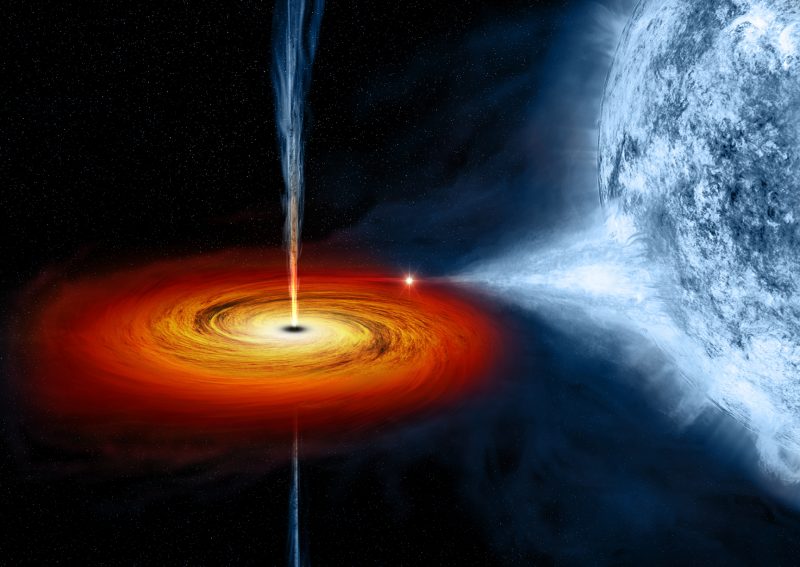
Black holes are surely one of the most incredible phenomena in the universe. Their masses are so concentrated that their gravitational pull is powerful; nothing, not even light, can escape from inside them. We can see black holes only because material being drawn into them – such as stars that wander too close – typically form a rotating disk encircling the hole. Light and other radiation from this disk can be seen by telescopes, and there’s plenty to see. For example, fast-moving jets of material may be ejected from a disk surrounding a supermassive black hole. On June 15, 2018, NASA announced that astronomers have directly imaged the formation and expansion of a fast-moving black hole jet for the first time. Miguel Pérez-Torres, of the Astrophysical Institute of Andalucia in Granada, Spain, and an author on a new study in the peer-reviewed journal Science, described the finding:
Never before have we been able to directly observe the formation and evolution of a jet from one of these events.

The observations included 36 scientists from 26 institutions around the world. Scientists observed the powerful jet, in a pair of colliding galaxies called Arp 299, nearly 150 million light-years away, using radio and infrared telescopes such as the National Science Foundation’s Very Long Baseline Array (VLBA) and NASA’s Spitzer Space Telescope.
Individually, these galaxies are known as Arp 299 A and Arp 299 B. At first, astronomers thought the jet was a supernova explosion, since others had been seen in Arp 299 before. But subsequent observations, in 2011, indicated that the radio-emitting portion of the jet showed elongation and growing expansion, showing that it was a jet of material, not a supernova.
Astronomers had already identified the supermassive black hole at the center of Arp 299 B. It is 20 million times more massive than our sun. The material around this black hole is now thought to originate from a passing star more than twice the mass of our sun, which got ripped apart by the black hole’s powerful gravity.
Astronomers also used the Hubble Space Telescope to observe the black hole, both before and after the jet eruption. The rotating material emits both X-rays and visible light. Material in the jets is being ejected at almost the speed of light.

Being able to visually see one of these occurrences, known as tidal disruption events, is exciting, since astronomers have directly observed only a few before this.
So how was it discovered? The first hint was all the way back in 2005, when astronomers observed a bright infrared emission coming from the nucleus of one of the colliding galaxies in Arp 299. Later that same year, on July 17, the VLBA noticed a new and unique radio emission coming from the same location. Follow-up observations were done using the Nordic Optical Telescope on the Canary Islands and the Spitzer Space Telescope. According to Seppo Mattila at the University of Turku in Finland, and another author on the new paper:
As time passed, the new object stayed bright at infrared and radio wavelengths, but not in visible light and X-rays. The most likely explanation is that thick interstellar gas and dust near the galaxy’s center absorbed the X-rays and visible light, then re-radiated it as infrared.

Observations continued for almost a decade after that, which showed that the radio waves expanded in one direction, at about one-quarter the speed of light. This was consistent with a jet of material being ejected from the disk surrounding the black hole.
The disks form when material is being actively drawn in from nearby towards the black hole. Most of the time, however, black holes are more “quiet.” As noted by Perez-Torres:
Much of the time, however, supermassive black holes are not actively devouring anything, so they are in a quiet state. Tidal disruption events can provide us with a unique opportunity to advance our understanding of the formation and evolution of jets in the vicinities of these powerful objects.
As Mattila also noted:
Because of the dust that absorbed any visible light, this particular tidal disruption event may be just the tip of the iceberg of what until now has been a hidden population. By looking for these events with infrared and radio telescopes, we may be able to discover many more, and learn from them.
Being able to witness one of these TDEs in action is a huge bonus for scientists, and it will help them better understand how black holes form and behave, since the “hole” itself (really an extremely dense small object) cannot be seen.

Bottom line: Black holes are one of the most bizarre cosmic phenomena that we know of. The new observations show how black holes can not only suck material in, but also violently eject it as well, making them an even more compelling target of future study.
Source: Astronomers See Distant Eruption as Black Hole Destroys Star
Help EarthSky keep going! Please donate what you can to our annual crowd-funding campaign.











